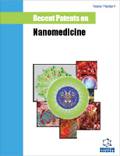Abstract
Photoacoustics, conceptually described as laser induced ultrasound, combines the advantages of optical and acoustic methods for detection and imaging of pathology in the human body. In photoacoustics, rapid pulsed laser light, usually on the nanosecond time scale, is irradiated onto tissue. Cells and tissue containing light absorbers undergo transduction of light energy into acoustic pulses, providing a robust means for signal propagation in the human body. For cells and tissue that do not have intrinsic light absorption, nanoparticles can be targeted using various means to provide optical contrast. This optical contrast may be provided by embedded dye molecules or through plasmon resonance. Recent patents have covered photoacoustic imaging of tumors targeted by various nanoparticles. Furthermore, nanoparticles have provided optical contrast for circulating tumor cells, those cells that travel in the bloodstream and are indicators of metastatic disease. This paper will discuss photoacoustic detection and imaging of cancer using various nanoparticles and their related intellectual property.
Keywords: Circulating tumor cells, flowmetry, optoacoustic, tumor, Photoacoustic detection, optical contrast agents, cancer, nanoparticles, tumor cells, melanin, lymphatic vessels, chromophores, cancer imaging, photoacoustic imaging, carbon nanotubes, photoacoustic technology
 11
11

